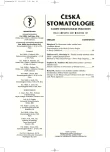Evaluation of Chemical Stability of Coating Layer of Zirconium Nitride on the Basic Construction from Chromium-cobalt Alloy
Authors:
S. Bartáková; P. Prachár; L. Cvrček 1; V. Březina; J. Vaněk
Authors‘ workplace:
Stomatologická klinika LF MU a FN u sv. Anny, Brno
přednosta prof. MUDr. J. Vaněk, CSc.
Stomatologické výzkumné centrum LF MU, Brno
hlavní řešitel prof. MUDr. J. Vaněk, CSc.
; HVM Plasma, Praha
1
Published in:
Česká stomatologie / Praktické zubní lékařství, ročník 107, 2007, 4, s. 63-66
Category:
Overview
In recent dental implantology, technically pure titanium or its alloys are broadly used as common metal material. The material possesses optimal biological characteristics. Unfortunately, its technological processing is difficult and limiting for production of some types of dental implants. Subperiostal implants might be pointed out in this respect. The objective of research project was to substitute titanium and titanium alloys for wellprocessed chromium-cobalt alloy coated with ceramic material ZrN or multilayered Zr/ZrN. Other objective was to prove its biocompatibility, full adhesivity and mechanical resistance. Results indicated high chemical resistance, of the material that, thanks to coating, reduced ion relase from chromium –cobalt alloy by 28-32 % in relation to surface roughness. Such results are very promising for dental implantology. The study presented in this paper was supported by project No. 7356-3 provided by the IGA MZ ČR ND grant agency. The research was carried out within the frame of Stomatological Research Center number1M0528 (SVC).
Key words:
implant – zirconium nitride – chromium-cobalt alloy – coating – ion – bioinertness
Labels
Maxillofacial surgery Orthodontics Dental medicineArticle was published in
Czech Dental Journal

2007 Issue 4
Most read in this issue
- Methods of Vital Pulp Therapy – Direct Pulp Capping
- The Use of FRC Retention Splint in Orthodontic Patient in Magnetic Resonance Examination
- Adhesive Systems in Prevention of Dental Caries
- Determination of the Risk of Caries Origin in Early Childhood
